International Journal of Image, Graphics and Signal Processing @ijigsp
Статьи журнала - International Journal of Image, Graphics and Signal Processing
Все статьи: 1157
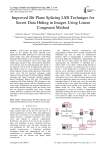
Статья научная
In this paper, we propose two algorithms based on the popular Bit Plane Splicing Least Significant Bit (LSB) Technique for secret data hiding inside images. One major disadvantage of Bit Plane Splicing LSB technique is its low hiding capacity which results in severe degradation of the cover image upon hiding large amount of data. The proposed algorithms overcome this issue by imposing hiding rules based on the intensity level of pixels. In addition the method for data hiding is done in a non sequential manner using linear congruent random number generators. Experiment results show that the proposed techniques called Optimum Intensity Based Distributed Hiding (OIBDH) technique and Linear Congruent Optimum Intensity Based Distributed Hiding with Key (LC-OIBDH-k) outperforms Bit Plane Splicing LSB technique as they have better hiding capacity with less degradation in the cover image. Furthermore, the proposed algorithms are tested using absolute entropy curves and results show that our proposed techniques have lower absolute entropy difference compared to Bit Plane Splicing LSB technique in all the tested images and for different secret data sizes.
Бесплатно
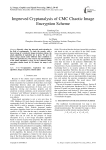
Improved Cryptanalysis of CMC Chaotic Image Encryption Scheme
Статья научная
Recently, chaos has attracted much attention in the field of cryptography. To study the security with a known image of a symmetric image encryption scheme, the attack algorithm of equivalent key is given. We give the known image attacks under different other conditions to obtain the equivalent key. The concrete step and complexity of the attack algorithm is given. So the symmetric image encryption scheme based on 3D chaotic cat maps is not secure.
Бесплатно

Статья научная
The purpose of speech emotion recognition system is to classify speaker's utterances into different emotional states such as disgust, boredom, sadness, neutral and happiness. Speech features that are commonly used in speech emotion recognition (SER) rely on global utterance level prosodic features. In our work, we evaluate the impact of frame-level feature extraction. The speech samples are from Berlin emotional database and the features extracted from these utterances are energy, different variant of mel frequency cepstrum coefficients (MFCC), velocity and acceleration features. The idea is to explore the successful approach in the literature of speaker recognition GMM-UBM to handle with emotion identification tasks. In addition, we propose a classification scheme for the labeling of emotions on a continuous dimensional-based approach.
Бесплатно
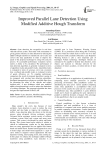
Improved Parallel Lane Detection Using Modified Additive Hough Transform
Статья научная
Lane detection has recognition in real time vehicular ad-hoc system. That study work concentrate on giving greater efficiency in lane detection by utilizing the additive Hough transform to identify the curve lanes and convert into data parallelism in order to improve the speed of the proposed technique by using fork and join process. To accomplish performance evaluation various metrics is likely to be considered. The performance of lane detection algorithms is generally evaluated in terms of algorithm results and parallel results. Algorithm results is evaluated in terms of accuracy, error rate, execution time ,overhead and parallel results is evaluated in terms of speed, efficiency etc. To complete performance comparison the result of proposed algorithm is going to be compared with existing lane detection algorithms. Intelligent transportation systems are available these days for increasing the safety of the vehicles and reduce incident ratio. A new technique which uses modified additive hough transform is used to reduce the limitations of existing technique. The proposed algorithm has been designed and implemented in MATLAB.
Бесплатно
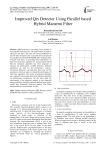
Improved Qrs Detector Using Parallel based Hybrid Mamemi Filter
Статья научная
QRS detection is becoming more popular in detecting the heart beat rate. The improvement is done by using the new filter. The data and control parallelism is used in order to improve the execution time and speed of the parallel based hybrid MAMEMI filter technique This research work focus on providing better performance in heart beat detection algorithm by using parallel hybrid filter.An enhanced algorithm has been proposed to enhance the performance of QRS detection. Different parameters are used for the performance analysis. Accuracy,F_Measure, and Detection_Error_rate are the parameters which are used to evaluate the performance of heart beat algorithm. The results of proposed algorithm are compared with existing heart beat detection algorithm for performance comparison. On the other hand the performance of the proposed method is also improved using parallelism. Parallel proposed method shows better results than Sequential proposed method. The Mean improvement in execution time is 0.80.
Бесплатно
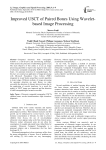
Improved USCT of paired bones using wavelet-based image processing
Статья научная
Computed ultrasonic bone tomography (USCT) is a non-invasive and non-ionizing technique, which ensures the protection of child being against x-rays. The main objective of this article is to use an image processing algorithm to improve the signal-to-noise ratio of ultrasonic computed tomography (USCT) of children bones for automatic detection of osteopathologies. For this fact, we construct an application of image processing with Microsoft Foundation Class Library (FMC) integrated in visual Studio using Haar wavelet algorithm to detect edges. Different methods of image processing for automatic detection are used. Hence, we make accessible the detection of distance between bones due to the application of wavelet transform. As a result, the quality of USCT image was improved and the detection of child osteopathologies became accessible.
Бесплатно
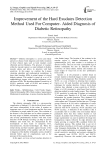
Статья научная
Diabetic retinopathy is a severe and widely spread eye disease. Early diagnosis and timely treatment of these clinical signs such as hard exudates could efficiently prevent blindness. The presence of exudates within the macular region is a main hallmark of diabetic macular edema and allows its detection with high sensitivity. In this paper, we combine the k-means clustering algorithm and mathematical morphology to detect hard exudates (HEs) in retinal images of several diabetic patients. This method is tested on a set of 50 ophthalmologic images with variable brightness, color, and forms of HEs. The algorithm obtained a sensitivity of 95.92%, predictive value of 92.28% and accuracy of 99.70% using a lesion-based criterion.
Бесплатно
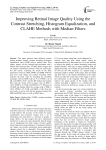
Статья научная
This paper performs three different contrast testing methods, namely contrast stretching, histogram equalization, and CLAHE using a median filter. Poor quality images will be corrected and performed with a median filter removal filter. STARE dataset images that use images with different contrast values for each image. For this reason, evaluating the results of the three parameters tested are; MSE, PSNR, and SSIM. With the gray level scale image and contrast stretching which stretches the pixel value by stretching the stretchlim technique with the MSE result are 9.15, PSNR is 42.14 dB, and SSIM is 0.88. And the HE method and median filter with the results of the average value of MSE is 18.67, PSNR is 41.33 dB, and SSIM is 0.77. Whereas for CLAHE and median filters the average yield of MSE is 28.42, PSNR is 35.30 dB, and SSIM is 0.86. From the test results, it can be seen that the proposed method has MSE and PSNR values as well as SSIM values.
Бесплатно
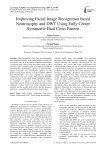
Статья научная
Face recognition is one of the most commonly used biometric features in the identification of people. In this article, a novel facial image recognition architecture is proposed with a novel image descriptor which is called as fully center symmetric dual cross pattern (FCSDCP) The proposed architecture consists of preprocessing, feature extraction and classification phases. In the preprocessing phase, discrete wavelet transform (DWT) and Neutrosophy are used together to calculate coefficients of the face images. The proposed FCSDCP extracts features. LDA, QDA, SVM and KNN are utilized as classifiers. 4 datasets were chosen to obtain experiments and the results of the proposed method were compared to other state of art image descriptor based methods and the results clearly shows that the proposed method is a successful method for face classification.
Бесплатно
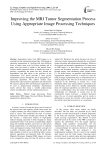
Improving the MRI Tumor Segmentation Process Using Appropriate Image Processing Techniques
Статья научная
Segmenting tumor from MRI images is an essential but time consuming manual duty. Performing an automatic segmentation is a defying task since different forms of tumor tissue exist for diverse patients and in many cases the tumor is similar to the normal tissue. Various studies proposed earlier to handle the issue of precisely segmenting the tumor but they discard the degradations and their effect to the precision of the segmentation. This article provides a more precise segmentation process through the use of appropriate pre-processing algorithms. The authors studied many enhancement and restoration algorithms and selected the NL-means, Laplacian filter and histogram equalization to be used as preprocessing techniques. Experimental results showed that using a suitable preprocessing scheme would produce a better segmentation process.
Бесплатно

Статья научная
The security of digital image watermarking is improved by scrambling the watermark using different chaotic maps or cellular automata in such a way that an unauthorized person can't recover the watermark without the secret keys. In this proposed scheme three secret keys are used in which one key is used to make the watermark chaotic and other two keys are used for scrambling the cover image. In this scheme the cover image is scrambled by using the game of life cellular automation and the watermark is made chaotic by performing the X-OR operation between the binary watermark and logistic map. Although it increases the computational complexities, but the security of watermarking is improved by involving three secret keys. In addition, for ensuring imperceptibility and making the watermarking robust, a mask of size 3×3 is run over the scrambled cover image in which one bit of chaotic watermark is embedded in 3×3 block of cover image by modifying one of the neighbor pixels. Then the scrambled modified cover image is descrambled using game of life cellular automation for obtaining watermarked image. This proposed combined chaotic and cellular automata based watermarking scheme is compared with existing chaotic based watermarking schemes and gives satisfactory values of Peak Signal to Noise (PSNR), Mean Squared Error (MSE) and Normalized Correlation (NC).
Бесплатно

Improving the sharpness of digital image using an amended unsharp mask filter
Статья научная
Many of the existing imaging systems produce images with blurry appearance due to various existing limitations. Thus, a proper sharpening technique is usually used to increase the acutance of the obtained images. The unsharp mask filter is a well-known sharpening technique that is used to recover acceptable quality results from their blurry counterparts. However, this filter often introduces an overshoot effect, which is an undesirable effect that makes the recovered edges appear with visible white shades around them. In this article, an amended unsharp mask filter is developed to sharpen different digital images without introducing the overshoot effect. In the developed filter, the image is smoothed by using the traditional bilateral filter and then blurred using a modified Butterworth filter instead of blurring it with a Gaussian low-pass filter only as in the traditional unsharp mask filter. Using this approach allowed to eliminate the overshoot effect and to recover better quality results. The proposed filter is assessed by using two modern image quality assessment metrics, real and synthetic-blurred images, and is compared with three renowned image sharpening techniques. Various experiments and comparisons showed that the proposed filter produced promising results with both real and synthetic-blurred images.
Бесплатно
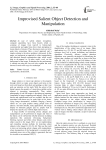
Improvised Salient Object Detection and Manipulation
Статья научная
In case of salient subject recognition, computer algorithms have been heavily relied on scanning of images from top-left to bottom-right systematically and apply brute-force when attempting to locate objects of interest. Thus, the process turns out to be quite time consuming. Here a novel approach and a simple solution to the above problem is discussed. In this paper, we implement an approach to object manipulation and detection through segmentation map, which would help to de-saturate or, in other words, wash out the background of the image. Evaluation for the performance is carried out using the Jaccard index against the well-known Ground-truth target box technique.
Бесплатно
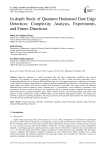
Статья научная
Quantum computing is a rapidly developing field with faster computational capabilities than classical computing. The popularity of quantum computing has reached the field of image processing, particularly with a breakthrough method known as Quantum Hadamard Edge Detection. This approach represents a significant advancement in edge detection techniques using quantum computing. Quantum Hadamard Edge Detection is a method that can detect image edges more quickly than classical methods with exponential acceleration. This paper explains the Quantum Hadamard Edge Detection method in detail, including how it is implemented, a time complexity explanation, some experiments, and future research directions. Our experiments utilize a quantum computer simulator and employ four measurement metrics: Structural Similarity Index, Figure of Merit, Entropy, and a Proposed Metric with radius-based features, to detect simple binary images, MNIST images, and the Berkeley Segmentation datasets. We recognize the potential of quantum computing and believe that image processing with quantum representation will make processing more efficient and significantly valuable in the future.
Бесплатно
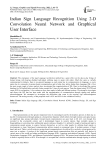
Indian Sign Language Recognition Using 2-D Convolution Neural Network and Graphical User Interface
Статья научная
The emergence of the sign Language recollection method has a great effect on the day-to-day livings of human beings with hearing disabled individuals utilizing signs to speak with others. Much the same as verbally communicated in dialects, there is no general language as each nation has its communication in language, so every nation has its vernacular of gesture-based communication and in India, they utilize Indian Sign Language (ISL). Over the most recent couple of years, analysts have investigated the computerization of ISL. Here we developed the custom database for 26 English letters and each Letter narrates the 5 times by each person. Train the dataset using 2D CNN and create GUI for recognition. A few endeavors have been made in India and different nations. We attempt to investigate and dissect the ISL that has been made with the mechanization of communication through signing and motion acknowledgment. We attempted to investigate the difficulties that come in the ongoing sign acknowledgment framework. The testing accuracy of the proposed work is 95% and 95% for the validation accuracy.
Бесплатно
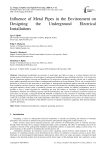
Influence of Metal Pipes in the Environment on Designing the Underground Electrical Installations
Статья научная
Underground installations are networks of metal pipes and cables in space at a certain distance from the ground surface. Insulating layers of metal pipes of underground installations (gas, plumbing, electrical...) do not provide their full protection against corrosion and breakdowns. In urban areas, wandering currents (electric rail or earthing of power plants) repeatedly increase failures in underground installations in the environment. That is why a certain kind of protection is foreseen for the protection of metal pipes of underground installations against corrosion and destruction from wandering currents. However, until today there is no universal method for calculating the parameters of stationary and quasi-stationary electric fields of wandering currents and a general solution for arbitrary configuration, but it is possible to form a model algorithm for controlling the state and failures of insulation of underground electrical installations. Solutions for wandering currents could be determined by the criterion of similarity to transient currents on power lines. In the paper, in program MATLAB Simulink a simulation for the correction of wandering currents using foreign grounding has been performed on certain parts of underground installations. It has been shown that the solution of the task is possible with help of the model-algorythm which allows a determinaitn of the power on isolation layer of the cable sheat, and with simulation of the different versions of schedule of protective equipment, their optimal schedule could be determined.
Бесплатно

Статья научная
At the current moment, all developed polarization methods utilize "single-point" statistical analysis algorithms for laser fields. A relevant task is to generalize traditional techniques by incorporating new correlation-based "two-point" algorithms for the analysis of polarization images. Theoretical foundations of the mutual and autocorrelation processing of phase maps of polarization-structural images of samples of dehydrated serum films are given. The maps of a new polarization-correlation parameters, namely complex degree of coherence (CDC) and complex degree of mutual polarization (CDMP) of soft matter layer boundary field by the example of dehydrated serum film samples are investigated. Two groups of representative samples, uterine myoma patients (control group 1) and patients with external genital endometriosis (study group 2), were considered. We applied a complex algorithm of analytical data processing - statistical (1stand 4th central statistical moments), correlation (Gram-Charlie expansion coefficients of autocorrelation functions) and fractal (fractal dimensions) parameters of polarization-correlation parameters maps. Objective markers for diagnosing extragenital endometriosis were found.
Бесплатно
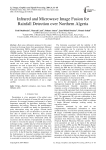
Infrared and Microwave Image Fusion for Rainfall Detection over Northern Algeria
Статья научная
Rain areas delineation proposed in this paper is based on the image fusion from geostationary Meteosat Second Generation (MSG) satellite, with the low-earth orbiting passive Tropical Rainfall Measuring Mission (TRMM) satellite. The fusion technique described in this work used an artificial neural network (ANN). It's has been developed to detect instantaneous rainfall by using information from the IR images of MSG satellite and from TRMM Microwave Imager (TMI). The study is carried out over north of Algeria. Seven spectral parameters are used as input data of ANN to identify raining or non - raining pixels. Corresponding data of raining /non-raining pixels are taken from a PR (precipitation radar) issued from TRMM. Results from the developed scheme are compared with the results of SI method (Scattering Index) taken as reference method. The results show that the developed model performs very well and overcomes the deficiencies of use a single satellite.
Бесплатно
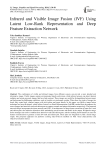
Статья научная
The combination of visible and infrared images from different sensors can provide a more detailed and informative image. Visible images capture environmental details and texture, while infrared sensors can detect thermal radiation and create grayscale images that have high contrast. These images are useful for distinguishing between target and background in challenging conditions, such as at night or in inclement weather. When these two types of images are fused, they create high- contrast images with rich texture and target details. In this paper, an effective image fusion technique has been developed, which utilizes Latent Low Rank Representation (LatLRR) method that decomposes the source images into latent low rank and salient parts to capture common and unique information respectively. The proposed network design incorporates the dense network and VGG-19 architectures for deep feature extraction of latent low- rank and salient parts, that minimize distortion while maintaining crucial texture and details in the output. Weighted average fusion strategies are used to combine these latent low-rank and salient parts, and the resulting fused features are used for feature reconstruction to generate a fused low-rank and salient part. These parts are integrated to yield a fused image output. The proposed approach out performs existing state-of-the-art methods on both visual characteristics and objective evaluation metrics.
Бесплатно
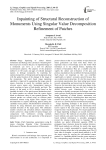
Статья научная
Image Inpainting of ruined historic monuments and heritage sites can help in visualizing how these may have existed in the past. An inpainted image of a monument can serve as a tool for physical reconstruction purpose. The purpose of the proposed method is to fill cracks and gaps of selected damaged regions in heritage monuments by exploiting the statistical properties of foreground and background along with the spatial location of the damage in the image of the monuments. The patch based image inpainting algorithm is improved by segmenting the image using K means clustering to search the candidate patches in relevant source region only. Segmentation improves patch searching in terms of both quality and time. The priority of the patch to fill is decided based on the standard deviation of the patch around destination pixel. Kn similar patches are selected from the source region based on minimum value of sum squared distance. The selected patches are refined using an efficient patch refinement scheme using higher order singular value decomposition to capture underlying pattern among the candidate source patches. The threshold for refinement is selected by using minimum and maximum value of standard deviation of the target patch. This eliminates random variation and unwanted artifacts. Experimental results carried on a large number of natural images and comparisons with well-known existing methods demonstrate the efficacy and superiority of the proposed method.
Бесплатно

